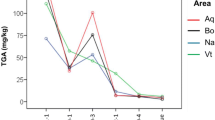Summary
Potato tuber glycoalkaloid content was measured in response to nitrogen fertilizer rate, storage temperature, length of storage period and cultivar. Cvs Gemchip, Norchip and Russet Burbank were grown with applied nitrogen fertilizer rates of 0, 168 or 336 kg/ha and then stored at either 4.4 or 10°C. Total glycoalkaloid content was determined one month before harvest, at harvest, after three months of storage and after nine months of storage. Higher rates of nitrogen, higher storage temperature and a period of storage all resulted in significantly (P<0.05) higher concentration of glycoalkaloids. The cv Norchip had higher glycoalkaloids than cvs Gemchip or Russet Burbank. Only the storage period had more influence than the environment (difference between years). Significant (P<0.05) two-way interactions were detected for year x cultivar, year x nitrogen, storage period x cultivar and nitrogen x cultivar. Most interactions were due to the unique responses of cultivars.
Similar content being viewed by others
References
Ahmed S.S. & K. Müller, 1978. Effect of wound-damages on the glyco-alkaloid content in potato tubers and chips.Lebensmittel-Wissenschaft & Technologie 11: 144–146.
Baker, D.C., R.F. Keeler & W. Gaffield, 1991. Toxicosis from steroidal alkaloids ofSolanum species. In: R.F. Keeler (Ed.), Handbook of natural toxins, Vol. 6 pp. 71–82. Marcel Dekker, Inc., New York.
Bergers, W. W., 1980. A rapid quantitave assay for solanidine glycoalkaloids in potatoes and industrial potato protein.Potato Research 23: 105–110.
Cronk, T.C., G.D. Kuhn & F.J. McArdle, 1974. The influence of stage of maturity, level of nitrogen fertilization, and storage on the concentration of solanine in tubers of three potato cultivars.Bulletin of Environmental Contamination and Toxicology 11: 163–168.
Fitzpatrick, T.J., S.F. Herb, S.F. Osman & J.A. McDermott, 1977. Potato glycoalkaloids: increases and variations of ratios in aged slices over prolonged storage.American Potato Journal 54: 539–544.
Gaffield, W., R.F. Keeler & D.C. Baker, 1991.Solanum glycoalkaloids: plant toxins possessing disparate physiologically active structural entities. In: R.F. Keeler (Ed.), Handbook of natural toxins, Vol. 6 pp. 135–158. Marcel Dekker, Inc., New York.
Gelder, W.M.J. van, 1991. Steroidal glycoalkaloids inSolanum: consequences for potato breeding and food safety. In: R.F. Keeler (Ed.), Handbook of natural toxins, Vol. 6 pp. 101–134, Marcel Dekker, Inc., New York.
Hilton, R.J., 1951. Factors in relation to tuber quality in potatoes. II. Preliminary trials on bitterness in netted gem potatoes.Canadian Journal of Agricultural Science 31: 61.
Kuc, J., 1984. Steroid glycoalkaloids and related compounds as potato quality factors.American Potato Journal 61: 123–139.
Maga, J.A., 1980. Potato glycoalkaloids.Critical Reviews in Food Science and Nutrition 12: 371–405.
McDole, R.E., D.T. Westermann, G.D. Kleinschmidt, G.E. Kleinkopf & J.C. Ojala, 1987. Idaho Fertilizer Guide-Potatoes. University of Idaho Current Information Series No. 261.
Mondy, N.I., A. Tymiak & S. Chandra, 1978. Inhibition of glycoalkaloid formation in potato tubers by the sprout inhibitor, maleic hydrazide.Journal of Food Science 43: 1033–1035.
Mondy, N.I. & C.B. Munshi, 1990. Effect of nitrogen fertilization on glycoalkaloid and nitrate content of potatoes.Journal of Agricultural and Food Chemistry 38: 565–567.
Nowacki, E., M. Jurzysta & P. Gorski, 1975. Study on the origin and protective function of alkaloids in plants. II. Effect of availability of nitrogen on alkaloid synthesis in solanaceae.Bulletin of Academie Polonaise des Sciences, Serie des Sciences Biologiques 23: 219.
Ponnampalam, R. & N.I. Mondy, 1983. Effect of cooking on the total glycoalkaloid content of potatoes.Journal of Agricultural Food Chemistry 31: 493–495.
Schreiber, K., 1968. Steroid alkaloids: theSolanum group. In: R.H.F. Manske (Ed.), The alkaloids, chemistry and physiology, pp. 1–192. Academic Press, New York.
Sinden, S.L., K.L. Deahl & B.B. Aulenbach, 1976. Effect of glycoalkaloids and phenolics on potato flavor.Journal of Food Science 41: 520–523.
Sinden, S.L., L.L. Sanford & R.E. Webb, 1984. Genetic and environmental control of potato glycoalkaloids.American Potato Journal 61: 141–156.
Tingey, W.M., 1984. Glycoalkaloids as pest restistance factors.American Potato Journal 61: 157–167.
Wilson, J.M. & J.S. Frank, 1975. The effect of systemic pesticides on total glycoalkaloid content of potato tubers at harvest.American Potato Journal 52: 179–184.
Zitnak, A., 1953. The influence of certain treatments upon solanine synthesis in potatoes. M.S. Thesis. University of Alberta, Edmonton, Canada.
Author information
Authors and Affiliations
Rights and permissions
About this article
Cite this article
Love, S.L., Herrman, T.J., Thompsonjohns, A. et al. Effect and interaction of crop management factors on the glycoalkaloid concentration of potato tubers. Potato Res 37, 77–85 (1994). https://doi.org/10.1007/BF02360434
Accepted:
Issue Date:
DOI: https://doi.org/10.1007/BF02360434




